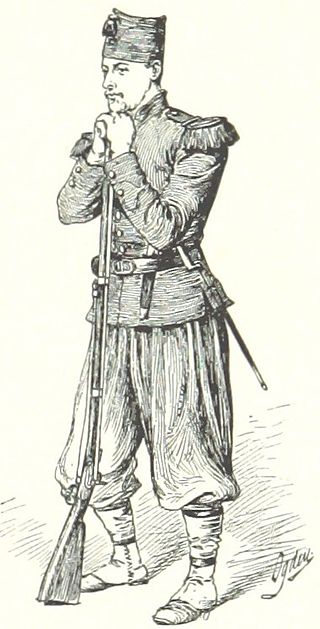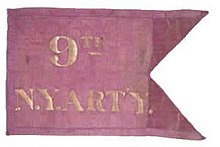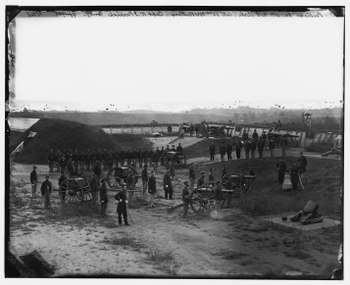
The 7th Rhode Island Infantry Regiment was an infantry regiment of the Union Army during the American Civil War.

William Henry Seward Jr. was an American banker and brigadier general in the Union Army during the American Civil War. He was the youngest son of William H. Seward, the United States Secretary of State under Abraham Lincoln and Andrew Johnson.

The 2nd Rhode Island Infantry Regiment was an infantry regiment composed of volunteers from the state of Rhode Island that served with the Union Army in the American Civil War. They, along with the 1st Rhode Island, wore a very simple uniform. The uniform composed of a dark blue jacket like shirt, tannish grey pants, and a dark blue chasseur kepi. The 2nd Rhode Island also wore havelocks in the beginning of the war, but after finding them useless they discarded them.

The 9th Illinois Infantry Regiment was an infantry regiment that served in the Union Army during the American Civil War.

The 42nd Regiment Illinois Volunteer Infantry was an infantry regiment that served in the Union Army during the American Civil War. It is one of the 300 fighting regiments.

The 9th Regiment Massachusetts Volunteer Infantry was a military unit from Boston, Massachusetts, USA, part of the Army of the Potomac during the American Civil War. It is also known as "The Fighting Ninth". It existed from 1861 to 1864 and participated in several key battles during the war. The unit is an Irish heritage unit, with many volunteers having been born in Ireland.
The 1st Kansas Colored Infantry Regiment was an infantry regiment that served in the Union Army during the American Civil War. It was the first black regiment to be organized in a northern state to see combat during the Civil War. At the Battle of Poison Spring, the regiment lost nearly half its number, and suffered the highest losses of any Kansas regiment during the war.
The 9th Louisiana Infantry (African Descent), later reorganized as 1st Mississippi Colored Heavy Artillery and then renamed 5th U.S. Colored Heavy Artillery, was an African-American regiment in the Union Army during the American Civil War. It famously fought in the Battle of Milliken's Bend; one of the earliest Civil War battles with African-American troops involved.

The 9th New York Infantry Regiment was an infantry regiment that served in the Union Army during the American Civil War. It was also known as the "Hawkins' Zouaves" or the "New York Zouaves."
The 1st Battalion of Massachusetts Volunteer Heavy Artillery was a unit that served in the Union Army during the American Civil War. It was organized from several unattached companies of heavy artillery already raised and mustered into a three-year service for the defenses of the Massachusetts coast.
The 79th United States Colored Infantry was an all-black infantry regiment which fought for the Union Army during the Civil War. "... in August, 1862, recruiting for a colored regiment was commenced in Kansas, and over 600 men were soon mustered in. The regiment, however, was not mustered into the United States service until January 13, 1863. It was then designated the 1st Kansas Colored Infantry Regiment, but its name was changed, in December, 1864, to the 79th United States Colored Infantry."

The 83rd Pennsylvania was a volunteer infantry regiment in the Union Army during the American Civil War, which participated in almost every major battle in the East, including Seven Days Battles, Antietam, Fredericksburg, Gettysburg, Petersburg and Appomattox Court House.
Camp Edwin M. Stanton was an American Civil War training camp that existed from 1861 to 1862 in Lynnfield, Massachusetts. When the camp first opened in 1861 it was known as Camp Schouler, named for Massachusetts Adjutant General William Schouler. In some references it is misspelled as Camp Schuyler. After President Abraham Lincoln's call for 300,000 troops in July 1862, the camp was revived and renamed in honor of United States Secretary of War Edwin M. Stanton. It served as the training camp and rendezvous for recruits from eastern Massachusetts. The camp trained ten infantry regiments and four artillery batteries of the Massachusetts militia, including the 17th, 19th, 22nd, 23rd, 33rd, 35th, 38th, 39th, 40th, and 41st regiments of infantry and the 3rd, 5th, 9th, and 10th batteries of light artillery. Soldiers stationed at Camp Schouler/Stanton during training included Edward A. Wild, Henry Wilson, Nelson A. Miles, Edward Winslow Hinks, and Arthur F. Devereux. During World War I it was renamed Camp Houston and served as a Massachusetts National Guard mobilization camp in 1917. It was located on the Newburyport Turnpike near the Peabody, Massachusetts line. The camp was divided into streets, with tents and cook houses located on both sides of the Turnpike to Suntaug Lake.

The 66th New York Infantry Regiment was an infantry regiment in the Union Army during the American Civil War.
The 8th New York Heavy Artillery Regiment, U.S. Volunteers was a heavy artillery regiment that served in the Union Army during the American Civil War. The regiment operated as both heavy artillery and infantry beginning in October 1862 while serving in the defenses of Baltimore, Maryland and continued in both capacities until the end of the war.
The 11th Independent Battery, New York Volunteer Light Artillery or 11th New York Light Artillery was an artillery battery that served in the Union Army during the American Civil War.
The 9th Massachusetts Battery was an field artillery battery that served in the Union Army during the American Civil War.

The 5th Regiment Massachusetts Volunteer Militia was a peacetime infantry regiment that was activated for federal service in the Union army for three separate tours during the American Civil War. In the years immediately preceding the war and during its first term of service, the regiment consisted primarily of companies from Essex County as well as Boston and Charlestown.
George W. Brinkerhoff was an American farmer and politician from New York.
Anson Sprague Wood was an American lawyer and politician from New York.










